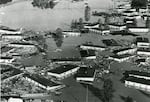During the early 1940s, Vanport, Oregon, was the second largest city in the state. But on a Sunday afternoon in May 1948, it disappeared completely — destroyed by a catastrophic flood.
A national emergency had created the city. World War II turned the Portland-and-Vancouver area into a major shipbuilding hub, and many thousands of workers from across the country began arriving for jobs in the shipyards. The Northwest migration caused a major housing shortage in the Portland area.
By early 1942 nationally known industrialist Henry J. Kaiser was operating three major shipyards in the area. He was building ships quickly for the war effort, but Portland was lagging far behind in providing housing. Impatient with city officials, Kaiser acquired funds directly from the federal government and proceeded to build the largest single federal wartime housing project in the country. Although built on a flood plain and surrounded by dikes and levees, Vanport was conveniently close to the shipyards. During its heyday it housed about 42,000 workers and their children.
The city was built quickly and never meant to be permanent. The crowded apartment buildings were prefabricated and lacked cement foundations. A noisy, 24-hour city, it also offered progressive services, including grade schools that operated year round, 24-hour day care for preschool children and the first black school teachers in Oregon. The housing was segregated: blacks were steered towards certain parts of town, whites to another — but the schools were integrated. Children of all races learned together and played together.
As the war came to a close, the shipyards laid workers off. Many of the transplanted workers — both black and white — decided to stay in the Northwest. And that presented a problem for Portland. Discriminatory banking and real estate practices prevented African-Americans from buying or renting in most parts of the city. As more whites were able to move out and find alternative housing, Vanport City became increasingly African-American.

Lifeline
Courtesy Oregon Historical Society, OrHi52428
In 1948, about 18,500 people still lived in the city. About one-third of the population was black. That spring, heavy snowfall in the mountains and sudden warm temperatures sent a torrent of water down the Columbia River. Vanporters were assured that the dikes would hold. But on Memorial Day weekend, one of the dikes collapsed. Vanport City disappeared under water in less than two hours. The catastrophic regional flood produced a sea of refugees – many with few options for permanent housing.

Flood destruction
Courtesy Oregon Historical Society, Neg. 67592
This is the story of Vanport: what it was like to live there, how it suddenly ended, and how it changed the face of Portland.
Resources and Information
Books
- Carl Abbott, Portland: Planning, Politics, and Growth in a Twentieth Century City, University of Nebraska Press, 1983.
- Manley Maben, Vanport, Oregon Historical Society Press, 1987
- Zita Podany, Vanport, Arcadia Publishing, 2016
Articles
- Karen J. Gibson, "Bleeding Albina: A History of Community Disinvestment, 1940-2000," Transforming Anthropology, Vol 15, No. 1, pp. 3-225.
- Stuart McElderry, "Building a West Coast Ghetto: African-American Housing in Portland, 1910-1960," The Pacific Northwest Quarterly, Vol. 92, No. 3, pp. 137-148.
- Stuart McElderry, "The Vanport Conspiracy Rumors and Social Relations in Wartime and Post-War Portland," Oregon Historical Quarterly, Vol. 99, No 2, pp. 134-163.
- Rudy Pearson, "A Menace to the Neighborhood: Housing and African Americans in Portland," 1941-1945, Oregon Historical Quarterly, Vol. 102, No. 2, pp. 158-179.
- Dale Skovgaard, "Oregon Voices: Memories of the 1948 Vanport Flood," Oregon Historical Quarterly, Vol 108, No. 1, pp. 88-106.
- Natasha Geiling, "How Oregon's Second Largest City Vanished in a Day," Smithsonian Magazine, February 2015
Websites
- Vanport Mosaic
- The Wake of Vanport
- Vanport, Oregon
- Portland City Archive & Records Center
- The Oregon Historical Society
- Portland State University Library, Special Collections & Archives
- Multnomah County Archives
